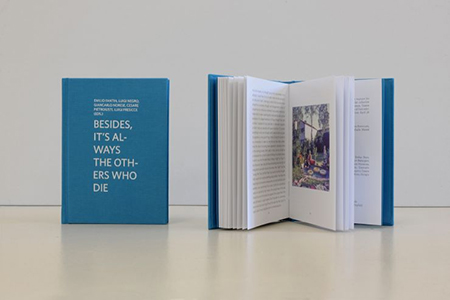Taking as its starting point a pilgrimage that takes place in Italy during the day of the dead, this publication is part of a collective and multidisciplinary project which aims to reflect upon death, to more deeply celebrate life.
This book, whose title is the epitaph on
Marcel Duchamp's tombstone, is one of several initiatives that we have developed around the theme of death, starting from “The Celebration of the Living (who reflect upon death).”
We have proposed turning the traditional November 2 celebration, the “Day of the Dead,” into a new holiday. For the first edition of this celebration on November 2, 2010, we invited those who were interested to be part of a pilgrimage, probably the shortest and slowest in the world, that departed from its destination (rather than arriving at it): Lu Cafausu in San Cesario di Lecce.
Lu Cafausu is a mysterious small building, an architectural remnant that we have elected as a source of metaphors and narratives. It is “an imaginary place that really exists,” around which the presence of death floats. Any day now, in fact, the small building might be demolished to accommodate more parking space for cars, or might also fall apart due to its old, fragile architecture. It could also be turned into a frozen, dead monument. Because of this feeling of the presence of death, Lu Cafausu is an ideal place for a new celebration. “La Festa dei Vivi” is for those who, in order to give meaning to life, reflect upon death; their own, first and foremost.
This book is an opportunity to include—instead of our previous texts or documentation of projects—some ongoing ideas and suggestions coming from encounters with old and new friends. We would like the book to address the theme of death from different points of view, and we would like to include as a connection to it, the accident, chance, the unexpected, or, let's say, the “cafausic” (referring to Lu Cafausu's arcane properties… ).
Gelosia (Jealousy) was, by chance, the name of our boat during the 2010 pilgrimage. Jealousy is a feeling related to the death of love, and yet at the very heart of love's aliveness… Lu Cafausu taught us that coincidences are meaningless if taken as mere coincidences: only when you are aware of connections can you become free to open yourself to their mystery, to their truth or, rather, to their multiple, inextricable, and fragile truths. And then, after all, as it happens, it's always us who die.
With a collective text based on an “Exquisite corpse,” a conversation held in Rome on January 19, 2014, between Emilio Fantin, Luigi Negro, Giancarlo Norese,
Cesare Pietroiusti,
Luigi Presicce, Sara Alberani, Lisa Batacchi, Marco Benincasa, Carolyn Christov-Bakargiev, Sarah Ciracì, Irene Coppola, Gianluca Marinelli, Luca Musacchio, Caterina Pecchioli, Mattia Pellegrini, Davide Ricco, and Roberto Tenace. And a series of twelve drawings by Francesco Lauretta portraying people in the pose of recently dead bodies, executed during the 4th edition of “The celebration of the living (who reflect upon death),” November 2, 2013, in Porto Cesareo; eight black-and-white photographs by an unknown photographer, found at the Porta Portese flea market, Rome, January 19, 2014; eleven color photographs by an unknown photographer, found at the Porta Portese flea market, Rome, January 19, 2014, a photograph of the exhibition “Gelosia” at the KMD, and notes and additional notes by a Yreen Anastas and Rene Gabri, Stefan Banz, Francesca Marianna,
Adrian Paci, Antonella Rizzo, Giorgio Rizzo, and Franco Vaccari.


